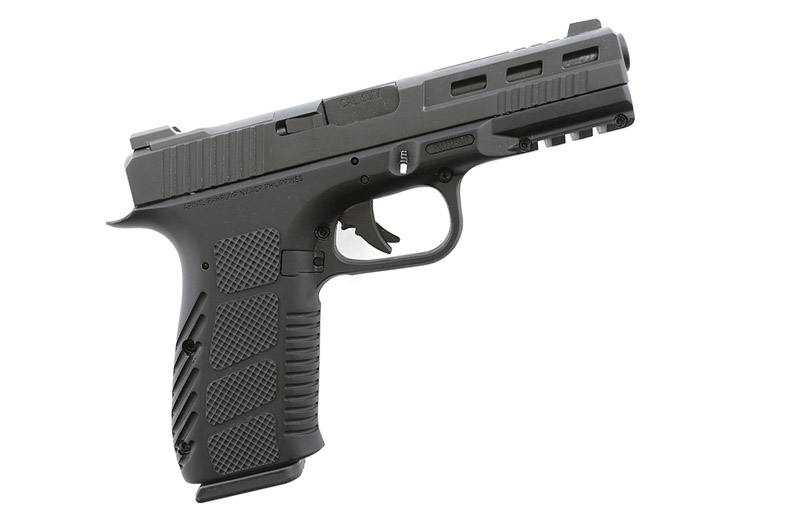There are many 9mm pistols on the market with large magazines. Armscor is the right choice. Why the STK100 Simple: no polymer. The STK100 looks just like a Glock (let’s just say the “G word”), but it also has no polymer. It uses Glock magazines and has parts interchangeability with Glock pistols. Despite the fact that the 1911 had a head start of 70 years and two World Wars, the STK100 is still a great choice. The STK100 is not made of polymer. What is it made of? Aluminum. Steel. The frame is made up of two aluminum shells. The shells are made by milling 7075 alloy aluminum blocks. The two halves are then bolted together using six strong fasteners. The bolts and screws holding them in place can be seen. Two are located in the grip frame, behind the backstrap. Two are located on the dust cover, across the accessory rail. The other two are located on the trigger guard’s front and rear. You can see the serial number poking through aluminum shell on the right. The STK100 runs on actual rails and not the four stamped tabs used by Glocks. First, the grip was designed to fit the 1911 grip angle and not the Glock angle. People who have used 1911s will notice that the Glock does not point the same way. While point-shooting is not something we should do, the Glock’s grip isn’t as sharp. To engage your fleshy hand, the grip’s rear has deep and diagonal grooves. The sides feature checkerboard panels that give your fingertips purchase and the rest your hand a grabby surface. The horizontal grooves on the frontstrap make it an effective setup. The diagonal grooves on the backstrap grip into your fleshy hand and resist recoil movement. These grooves work. Armscor also added an extended tang to the frame halves when they were being machined. Glocks’ tiny nub of polymer doesn’t always prevent muzzle lift. There is no leverage to stop the roll. The STK100 does a better job thanks to its longer tang. The STK100’s higher aluminum density than polymer also helps. The G17, which the STK100 is a clone, is listed at 22 ounces. The STK100 is 28 ounces. Although 6 ounces may seem small, it is not in the system’s reciprocating mass and acts as a dead weight to resist inertia. It’s a great help. Armscor has improved the block Glock slide. Armscor began by rounding the edges and corners to make it less blocky. This also helps to reduce weight. To remove more weight, they made clearance slots in the slide. The sides and top get cosmetic sculpting. On the widest portion of the front, there are cocking serrations. Due to the reduced weight, there is less reciprocating mass and less resistance to the rear end of this cycle. The muzzle-rise component of recoil is less driven by a lower bottoming-out weight. This was evident in test-firing. The sights also get upgraded. The front is the standard (for Glocks anyway) blade that is set in an oval socket. It is fastened from underneath by a hex headed screw. Anyone who has used Glocks knows the importance of checking this before you shoot your new pistol. Loctite is your best friend because the tiny threads (I believe there are 60-70 tpi) don’t require a lot torque to tighten. Armscor is not to be blamed, it’s the design we all have. The rear sight also serves as an optics mounting plate covering. The rear sight is part a removable plate that allows the installation of a red dot optic. The rear sight is taken with the plate when it’s removed. This seems like a minor oversight as there’s enough room to have the rear view stay and mount a red dot. The footprint is set up to accommodate the Shield sights and all other red-dots with the same base size and screw pattern, which is quite a few. I would have tested the STK100 with red dots, but all of my red dots of that pattern were already being tested. The plate was removed and the fit was tight. This bodes well for red-dots that fit and stay in place. I tested the fit with several Glock mags, Magpul and ETS mags. All fit and all that were meant to drop free did so. I still have my original Glock mags from before American shooters decided they didn’t want magazines that “won’t fall”. They worked and fit well, but they didn’t fall free. They didn’t work as intended, so I’m not surprised or disappointed. The weight and distribution of the weight, together with the griptang, do a great job keeping muzzle rise under control. It was easy to hammer the steel plates with the +P ammo. Armscor deserves points for all of these. Two KCI made in Korea magazines containing 17 rounds each were included with the sample gun. Standard Glock mags will work as that was the plan. The STK100 straight out of the box hit the sights and the plain black rear with white dots worked perfectly. I found the grip angle to be very comfortable, although I have shot a lot with 1911s so it is not surprising. The grip angle was perfect for me, but in recoil the front sight fell right back into the notch at the rear. This is why the nonslip grip texture does a great job of reducing recoil squirm. The cold snap that occurred during my range days with the STK100 was quite severe. I had to grab an all-aluminum grip as temperatures rose to 20. After some handling and shooting, the STK100 warned up. However, the first magazine from the STK100 was informative. I usually do the chronograph work first to determine velocities as well as check basic function. The first few groups would have been pretty bad if I hadn’t done the accuracy work first. But I was ready to shoot groups by the time the STK100 was warmed up and the sun was out, so I knew what I could expect. Accuracy? It is very good. Velocity was calculated using a Labradar chronograph that is programmed to measure velocity at 15 feet from the muzzle. The STK100 is designed to provide Velocity, which is averaging 10 shots at 20 degrees F. It’s not the right gun if you’re looking to carry a light gun. It is heavier than other pistols. You can get a heavier-than polymer pistol for competition. The STK100 is a heavier-than-polymer pistol that you can get for competition. It has a great trigger, which is a function of the stiffer frame and soft in recoil (weight/tang), making it fun to shoot in matches. Even though they reduce recoil, the extra ounces won’t be noticed in a proper bag. Do you want to disassemble your holster? If you can do it to a Glock you will know how it is done to an STK100. The process is simple if you don’t know how to do it to a Glock. Target grids and bullseye sizes can be downloaded in MOA. This is a great option for long-range shooting. Enter your email address below.

















